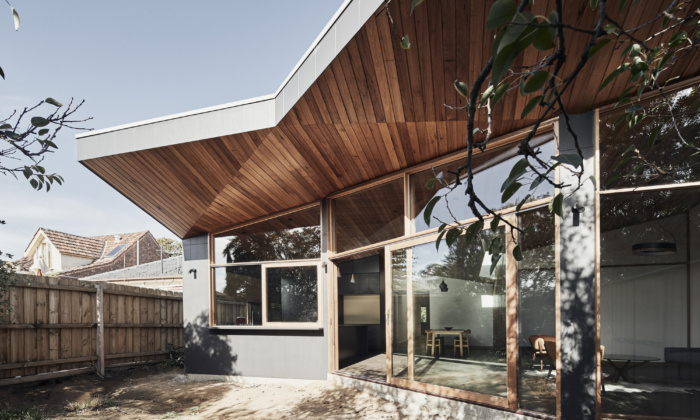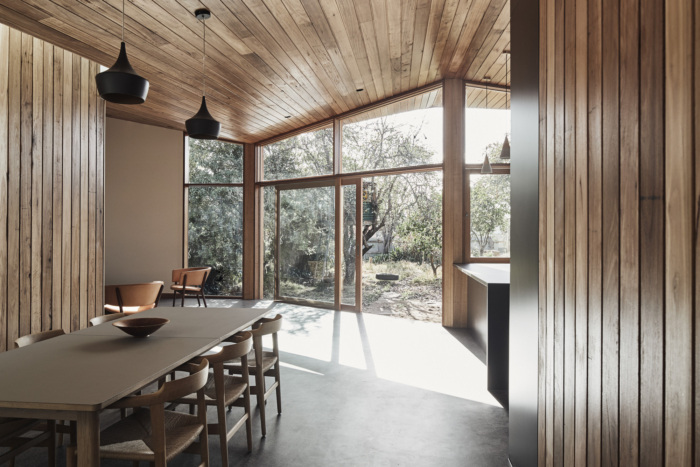Barton House
Julie Firkin Architects thoughtfully created a sustainable design for this Melbourne home, a space fit to adapt for the different stages of a growing family.
A dramatic timber ceiling unfolds out from a capacious living zone to shade the northern facade of this family home. The facade is angled to take in the best garden views and solar aspect. The house is designed to endure as the family grows. It utilises tough materials like Australian hardwood and the structural concrete floor slab is exposed. Adjacent the main living area is a screened-off playroom, and beyond this are four bedrooms and plenty of utility space.
The original house is an unassuming brick veneer, one of many in a street of post-war homes of the type made famous by Australian artist Howard Arkley. To maintain the suburban landscape, the front of the house has been kept intact and is entered via the original corbelled brick porch. Moving down a corridor which services the bedrooms, bathrooms and utility area, one approaches the new addition at the back of the house which opens up with a shift in scale, views and natural light.
The new addition embraces the midcentury aesthetic and postwar improvements in convenience and live-ability. But these ideals are seen from a contemporary perspective and adapted to suit a busy professional couple with a large family. The new living spaces are zoned but interconnected. The kitchen has views to the living and dining areas and is highly connected to the garden, with a servery as well as window splash-backs. A large sliding door is employed in the playroom so that the degree of family togetherness can be calibrated.
True to the midcentury palette, the character of the materials is expressed, resulting in a pleasing clash of hardwood, ground concrete, dark joinery and garden views. The spatial arrangement is housed within a chamfered and facetted envelope, using minimal ornamentation to achieve uncluttered spaces, sleek lines and clear geometric forms.
The brief was to preserve as much of the original house as possible and convert it into a four-bedroom family home. The owners wanted a main living space with a sense of originality and expressed materials like timber and concrete. They wanted the house to be light and thermally efficient. We added a two bedrooms, bathroom, ensuite, utility, kitchen, living/dining and playroom.
The biggest challenge on the project was that the budget was modest but we needed the finished house to be beautiful but also robust enough for a family with three small children. The original house had been owner built and needed a lot of repairing.
Our approach was to use common, cost-effective materials like an exposed structural floor slab, FC sheet cladding and colorbond roofing. The extensive use of Australian hardwood was the only extravagance in terms of material choice. In addition, we developed an uncomplicated single storey layout, with more complex geometric maneouvres saved for the main living areas which address the back garden.
The sustainability strategy was to keep and reuse as much of the original house as possible and to orient the house so that it took advantage of the north-facing garden aspect. The house has large north facing windows and an overhanging roof which shades the house in summer but allows the winter sun in. In winter almost the entire concrete floor of the living area is bathed in sunlight. The concrete acts as thermal mass, soaking up the sun’s warmth and re-radiating it into the house throughout the the day and night.
Design: Julie Firkin Architects
Photography: Peter Bennetts















